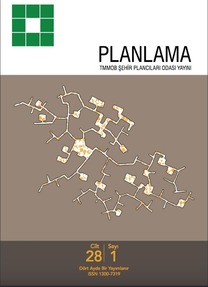Yeni Bir Soylulaştırma Formu Olarak Öğrencileştirme (Studentıfıcatıon): Bosna-Hersek Mahallesi’nde (Konya) Değişen Mahalle İçi Dinamikler
Studentification as a New Form of Gentrification: Changing Neighborhood Dynamics in Bosna Hersek Neighborhood (Konya)
___
- Allinson, J. (2006). Over-Educated, Over-Exuberant and Over Here ? The Impact of Students on Cities. Planning, Practice & Research, 21(1), 79–94. http://doi.org/10.1080/02697450600901541
- Atik, H. (1999). Üniversitelerin Yerel Ekonomiye Katkıları: Teori ve Erciyes Üniversitesi Üzerine Bir Araştırma. Erciyes Üniversitesi İ.İ.B.F. Dergisi, 15, 99-111.
- Arslan, H. (2014). Çankırı Karatekin Üniversitesinin Kente Ekonomik Katkısı ve Öğrenci Harcamalarının Farklı Değişkenler Açısından Analizi. Dicle Üniversitesi Sosyal Bilimler Enstitüsü Dergisi, 114–127.
- Aydemir S. E. (1994). Karadeniz Teknik Üniversitesinin Kent ve Bölge Ekonomisine Doğrudan ve Dolaylı Ekonomik Etkileri. Bölgesel Kalkınma Sempozyumu, Trabzon: Karadeniz Teknik Üniversitesi, 195-210.
- Bourdieu, P. (1977). Outline of a Theory of Practice. Cambridge:Cambridge University Press.
- Bourdieu, P. (1984) Distinction: a social critique of the judgement of taste. London:Routledge.
- Chatterton, P. (1999). University Students and City Centres - The Formation of Exclusive Geographies The Case of Bristol, UK. Geoforum, 30(2), 117–133. http://doi.org/10.1016/S0016-7185(98)00028-1
- Chatterton, P. (2010). The Student City: An Ongoing Story of Neoliberalism, Gentrification, and Commodification. Environment and Planning A, 42, 509–514. http://doi.org/10.1068/a42293
- Chatterton, P. ve Hollands, R. (2002). Theorising Urban Playscapes: Producing, Regulating and Consuming Youthful Nightlife Cityspaces. Urban Studies, 39, no.1 , 95-116.
- Davidson, M., ve Lees, L. (2005). New-build “gentrification” and London’s Riverside Renaissance. Environment and Planning A, 37(7), 1165–1190. http://doi.org/10.1068/a3739
- Duke-Williams, O. (2009). The Geographies of Student Migration in the UK. Environment and Planning A, 41(8), 1826–1848. http://doi. org/10.1068/a4198
- Erkekoğlu, H. (2000). Bölge Üniversitelerinin Yerel Ekonomiye Katkıları: Sivas Cumhuriyet Üniversitesi Örneği. Erciyes Üniversitesi İ.İ.B.F. Dergisi, 16, 203-210.
- Gotham, K. F. (2005). Tourism Gentrification: The Case of New Orleans’ Vieux Carre (French Quarter). Urban Studies, 42(7), 1099–1121. http://doi.org/10.1080/00420980500120881
- Görkemli, H. N., (2009). Selçuk Üniversitesi’nin Konya Kent Ekonomisine Etkileri. Selçuk Üniversitesi Sosyal Bilimler Enstitüsü Dergisi, 22, 169- 186.
- Gumprecht, B. (2013). The American College Town. Geographical Review, 93(1), 51–80.
- Hamnett, C. (2000). Gentrification, Postindustrialism, and Industrial and Occupational Restructuring in Global Cities. G.Bridge and S.Watson (Ed.), A Companion to the City içinde (s. 331–41), Oxford: Blackwell.
- He, S. (2015). Consuming Urban Living in “Villages in The City”: Studentification in Guangzhou, China. Urban Studies, 52(15), 1–25. http://doi. org/10.1177/0042098014543703
- Holdsworth, C. (2009). Between two worlds: local students in higher education and “scouse”/student identities. Population, Space and Place, 15(December 2008), 225–237. http://doi.org/10.1002/psp.511
- Holton, M. (2016). The geographies of UK university halls of residence: examining students’ embodiment of social capital. Children’s Geographies, 3285( June), 63–76. http://doi.org/10.1080/14733285.2014.979134
- Hubbard P, (2006). NIMBY by Another Name? A Reply to Wolsink. Transactions of the Institute of British Geographers, New Series 31, 92-94.
- Hubbard, P. (2008). Regulating the Social Impacts of Studentification: A Loughborough Case Study. Environment and Planning A, 40(2), 323– 341. http://doi.org/10.1068/a396
- Hubbard, P. (2009). Geographies of Studentification and Purpose-Built Student Accommodation: Leading Separate Lives? Environment and Planning A, 41(8), 1903–1923. http://doi.org/10.1068/a4149
- Tuğba Tuncer, Tolga İslam 313
- Karataş, M. (2002). Üniversitelerin Sosyo-Ekonomik Gelişmedeki Rolü ve Önemi:Muğla Üniversitesi Örneği, Doktora tezi, Muğla Üniversitesi/ Sosyal Bilimler Enstitüsü, Muğla.
- Kenyon, E. L. (1997). Seasonal Sub-communities: The Impact of Student Households on Residential Communities. The British Journal of Sociol -ogy, 48 (2), 286-301
- Lees, L., Slater, T., ve Wyly, E. (2008). Gentrification. New York:Routledge. Marcuse, P. (1986). Abandonment, Gentrification and Displacement: The Linkages in New York City. N.Smith and P.Williams (Ed.) Gentrification of the City içinde (s: 153–177), London: Allen and Unwin.
- Munro, M., ve Livingston, M. (2012). Student Impacts on Urban Neighbour -hoods: Policy Approaches, Discourses and Dilemmas. Urban Studies, 49(8), 1679–1694. http://doi.org/10.1177/0042098011419237
- Munro, M., Turok, I., ve Livingston, M. (2009). Students in cities : a Prelimi -nary Analysis of Their Patterns and Effects. Environment and Planning A, 41, 1805–1825. http://doi.org/10.1068/a41133
- Öztürk S. , Torun, İ. ve Sayın S. (2009). Üniversitenin Sosyo-Ekonomik Gelişmeye Etkisi: Kafkas Üniversitesi Örneği. İktisat Dergisi, 491, 71-84. Parsons, D. (1980). Rural Gentrification: The Influence of Rural Settlement Planning Policies. Department of Geography Research Paper No. 3, Uni -versity of Sussex, Brighton, U.K.
- Rugg, J., Rhodes, D. ve Jones, A. (2002). Studying a Niche Market : UK Stu -dents and The Private Rented Sector. Housing Studies, 17(2), 289–303. http://doi.org/10.1080/0267303022012323
- Smith D.P. (2002). Patterns and Processes of ‘Studentification’ in Leeds. Re -gional Reviews 11, 17–19.
- Smith, D.P. (2005). “Studentification”: the gentrification factory? R. Atkin -son & G. Bridge (Ed.). The New Urban Colonialism: Gentrification in a Global Context içinde (72–89), Routledge.
- Smith, D. P. (2009). “Student geographies”, Urban Restructuring, and The Expansion of Higher Education. Environment and Planning A, 41(8), 1795–1804. http://doi.org/10.1068/a42257
- Smith, D. P., ve Holt, L. (2007). Studentification and “Apprentice” Gentrifiers Within Britain’s Provincial Towns and Cities: Extending The Meaning of Gentrification. Environment and Planning A, 39(1), 142–161. http:// doi.org/10.1068/a38476
- Smith, D. P., ve Hubbard, P. (2014). The Segregation of Educated Youth and Dynamic Geographies of Studentification. Area, 46(1), 92–100. http:// doi.org/10.1111/area.12054
- Ünal, B. (2012). Kentleşme Sürecinde Üniversitenin Rolü: Amasya İli Örneği, Yüksek Lisans Tezi, Amasya Üniversitesi/Sosyal Bilimler Enstitüsü, Amasya.
- Yılmaz, C. (2011). Anadolu Kentlerinin Öğrencileşmesi: Başka Bir Kentleşme Deneyimi. Sosyoloji Dergisi, Vol:25, 1-17.
- ISSN: 1300-7319
- Yayın Aralığı: Yılda 3 Sayı
- Başlangıç: 1986
- Yayıncı: TMMOB Şehir Plancıları Odası
Harun EKİNOĞLU, AYŞE SEMA KUBAT
Büyük Şehirlerde Ulaşım Sistemleri ve Sorunları: İzmir İli Özelindeki Sorunlara Çözüm Önerileri
Fevzi Yasin KABABULUT, Cahit HELVACI
TUĞBA TUNCER TİRYAKİ, TOLGA İSLAM
Hanehalkı Konut Hareketliliğini Etkileyen Faktörler: Ankara Örneği
TANYEL ÖZELÇİ ECERAL, AYSU UĞURLAR
Dönüşüm Alanlarında Yaşam Kalitesi: Ankara, Akpınar Mahallesi’nden Ampirik Bulgular
EZGİ ORHAN, ZERRİN EZGİ KAHRAMAN
Türkiye’de Bölgesel Rekabet ve Rekabetçi Bölgeler
Koruma Odaklı Kırsal Alan Planlamasına Yönelik Veri Altyapısının Oluşturulması
AYGÜN ERDOĞAN, Sinem Dedeoğlu ÖZKAN, Beydullah SULAK, MELTEM BARUT
Parsel Bazındaki Dönüşüm Uygulamalarının Kentsel Maliyetleri, Karşıyaka-Bostanlı Mahallesi Örneği
Hayat Zengin ÇELİK, Tolga ÇİLİNGİR
MEDİHA BURCU SILAYDIN AYDIN, HİLMİ EVREN ERDİN, EMİNE DUYGU KAHRAMAN
